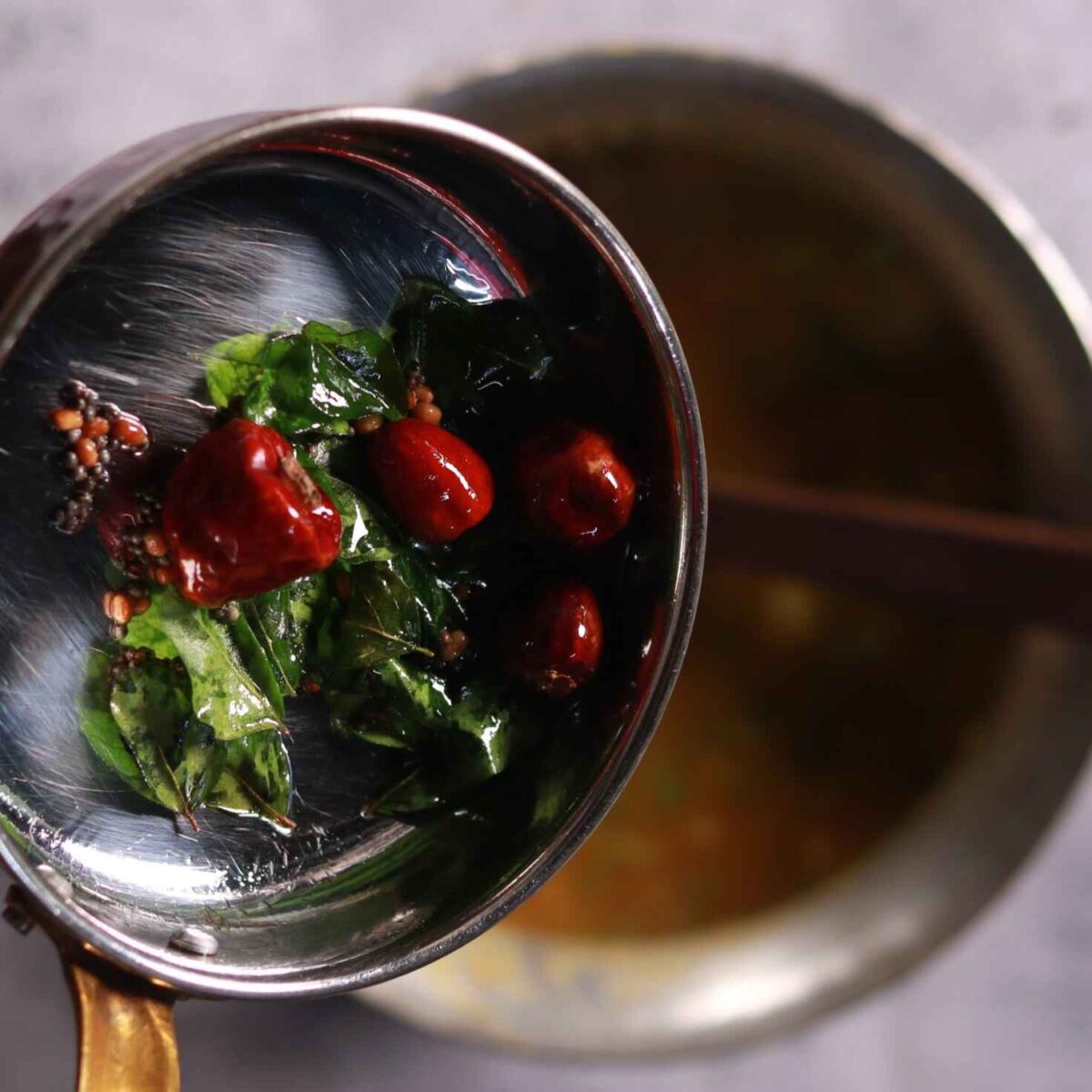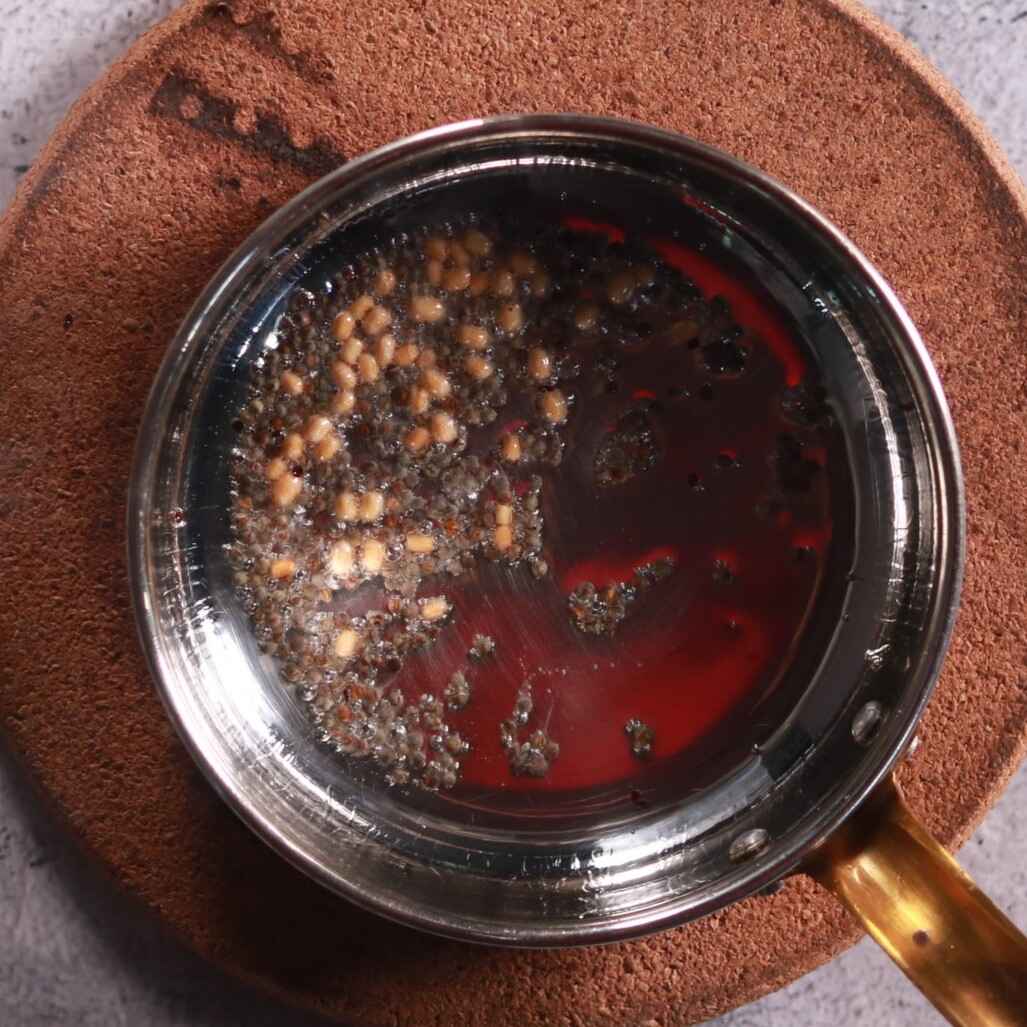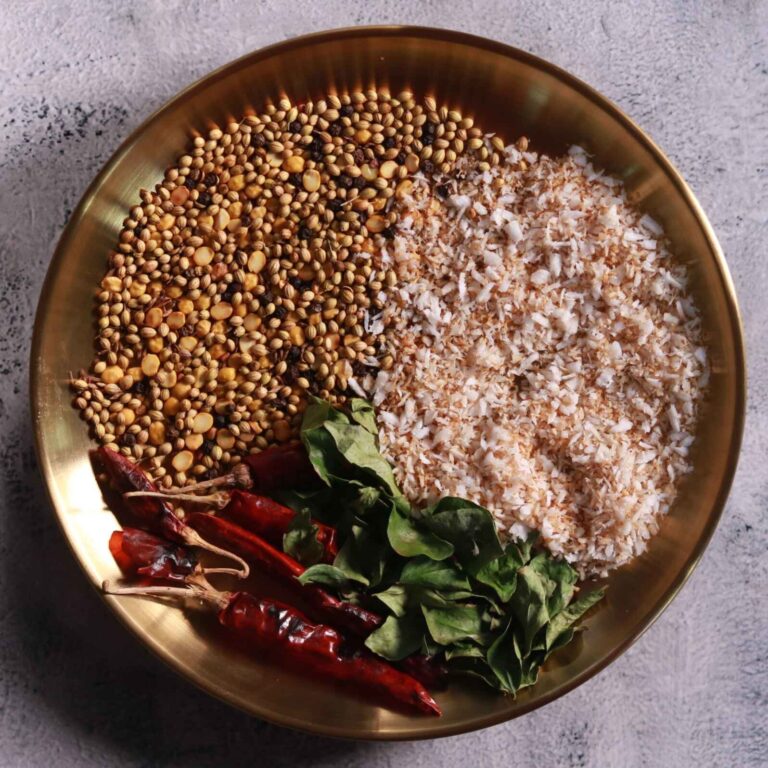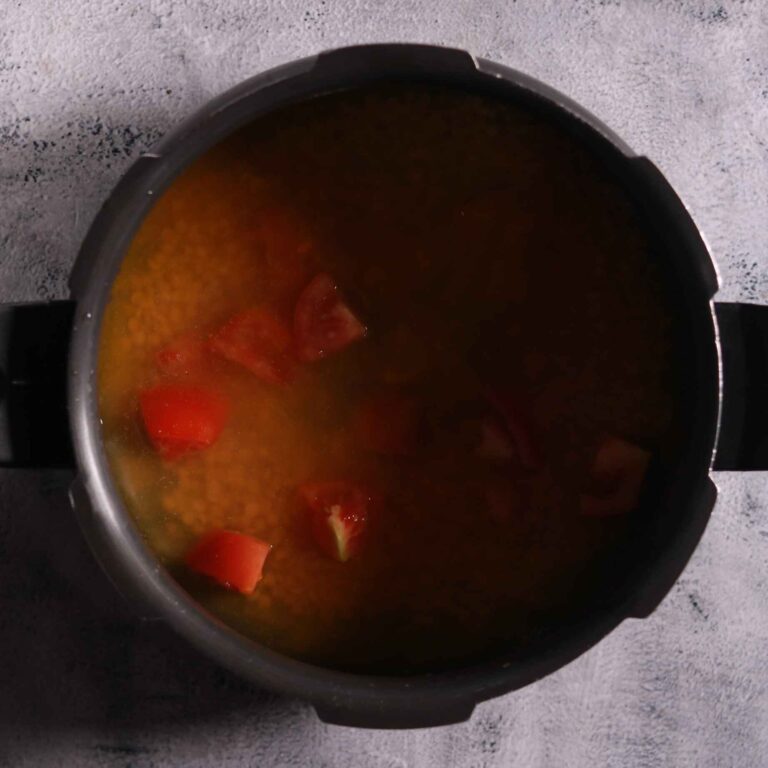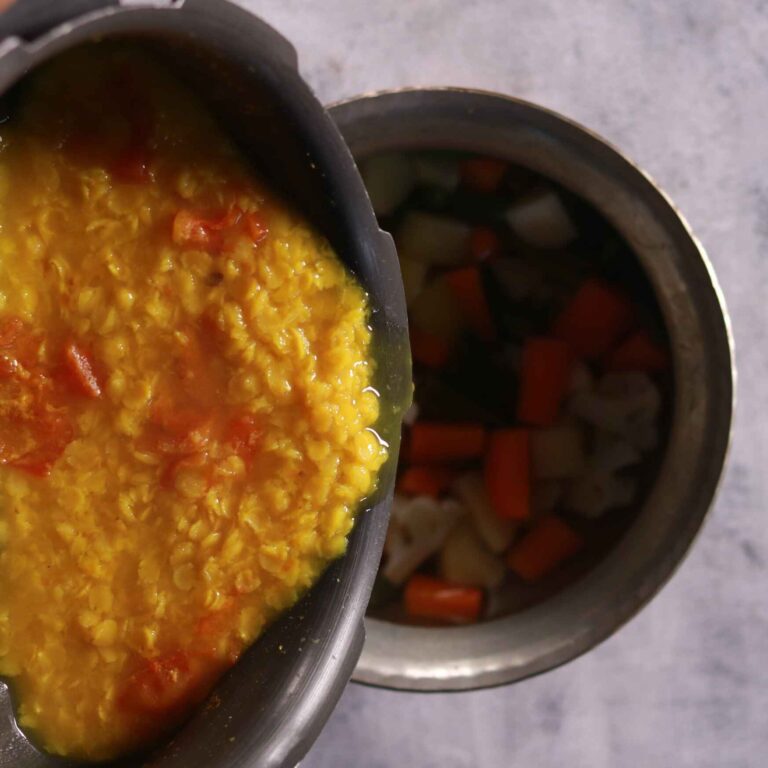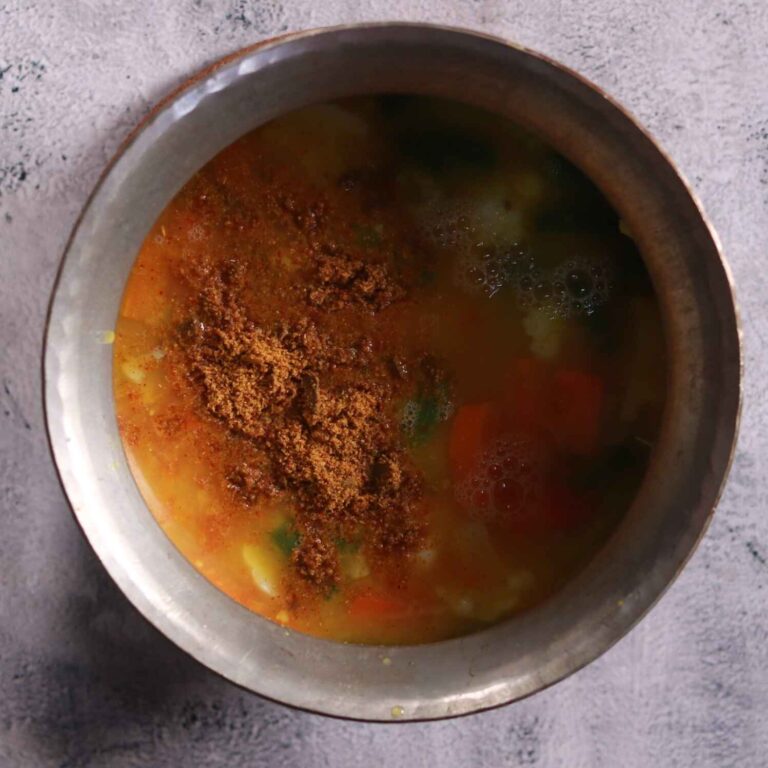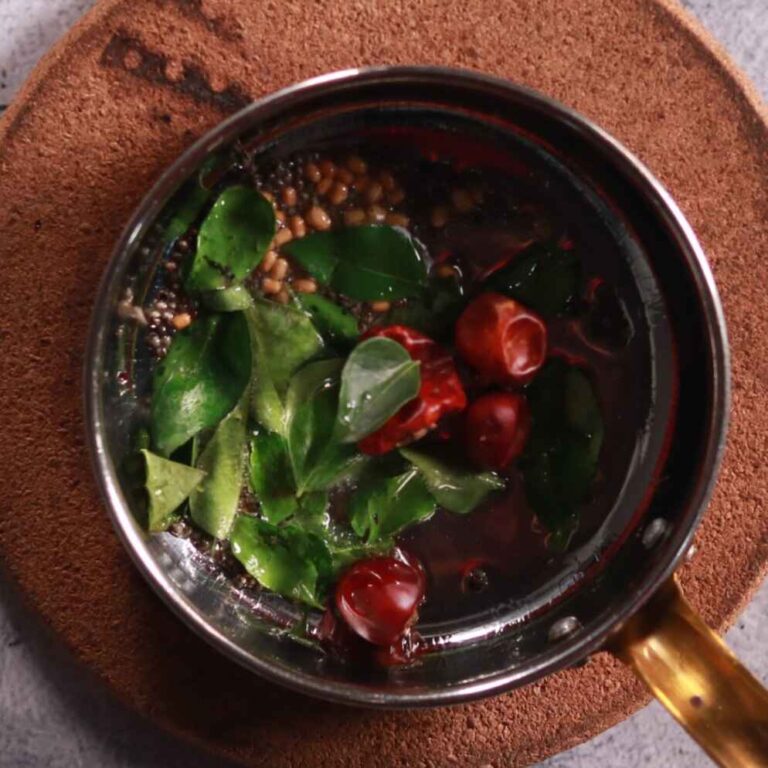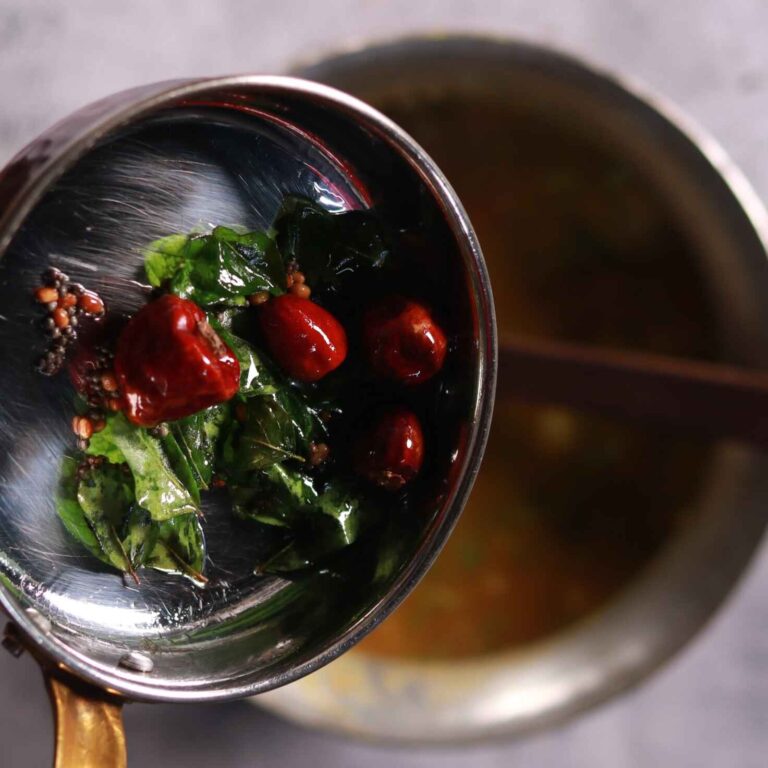If you’ve ever found yourself craving something cozy, nourishing, and bursting with flavor, let me introduce you to one of my all-time favorite dishes: authentic Tamil Sambar. This South Indian staple is like a hug in a bowl—full of tender veggies, creamy lentils, and a tangy, aromatic broth that’s just begging to be ladled over steaming rice or dunked with fluffy idlis.

Sambar is the kind of dish that makes me think of home, family dinners, and the simple joy of sharing good food with the people you love. Whether you’re a lifelong vegetarian or just looking to add more plant-based meals to your routine, Tamil Sambar is here for you.
When I was growing up in Dehradun, our Tamil neighbour would often visit to ask for fresh curry leaves from our backyard tree. The aroma of sambar from his kitchen always filled our home with warmth and curiosity. Years later, learning to make authentic sambar from a colleague brought back those cherished memories—the taste and smell instantly reminding me of my neighbor and the simple joys of sharing.
History & Tradition about Authentic Tamil Sambar
One of the most popular stories credits sambar’s invention to the Maratha rulers of Thanjavur in the late 1600s. The tale goes that Shahuji, a Maratha king, or maybe his chef, tried making a traditional Maharashtrian dal (called amti) but ran out of kokum, the usual souring agent. So, they used tamarind instead. The dish was served to Sambhaji (Shivaji’s son), and supposedly, it was so good they named it after him—“sambar.” Whether or not this is true, it’s a story that’s stuck around!
Legends aside, food historians point out that South India already had tangy, lentil-based stews long before the Marathas arrived. Ancient Tamil texts mention similar dishes, though the exact ingredients have changed over time.
Regional variations of the Sambar
Over time, sambar became a staple across Tamil Nadu, Karnataka, Kerala, Andhra Pradesh, and Telangana, with each region developing its own distinctive version by varying the choice of vegetables, spices, and souring agents. The dish also spread beyond India, becoming popular in Sri Lanka and among the Indian diaspora..

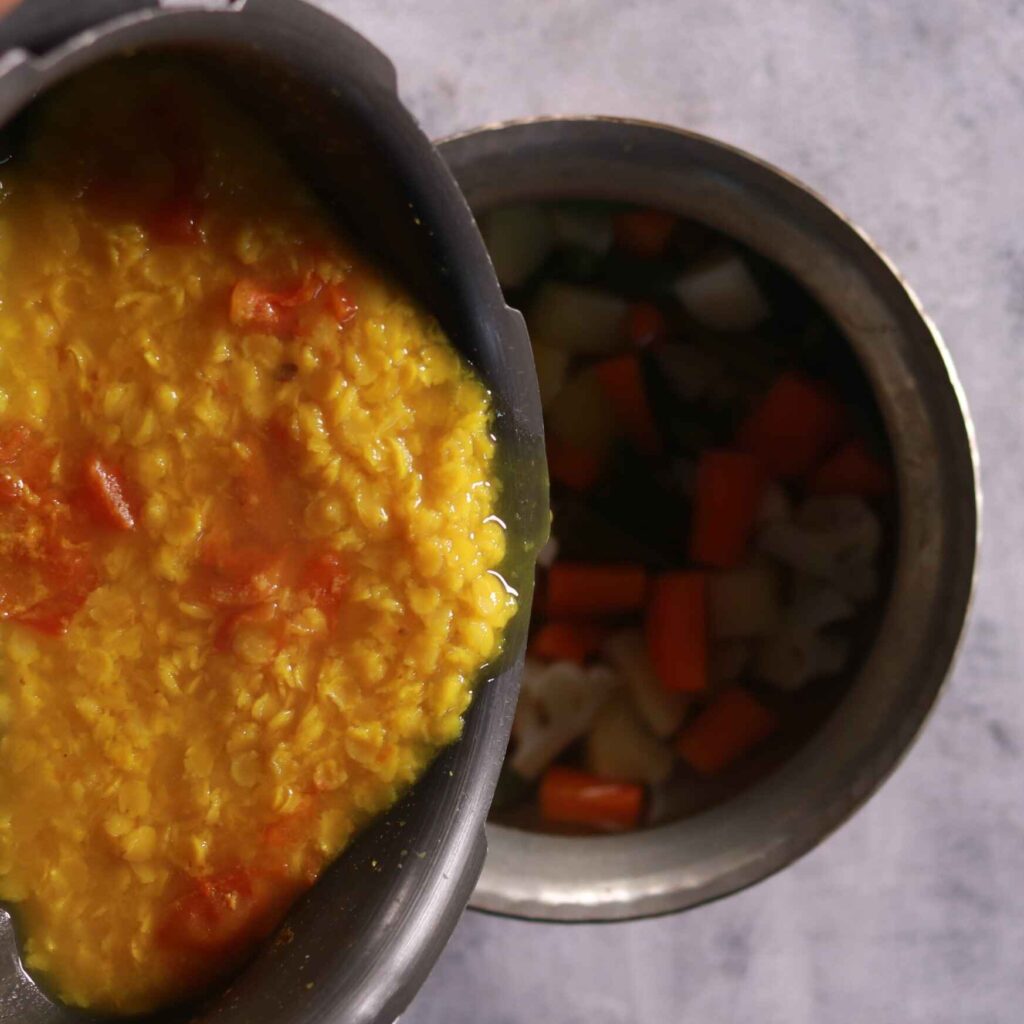
The Main Ingredients of Authentic Tamil Sambar
1.Sambar Powder
Sambar powder is the heart of Authentic Tamil sambar—a fragrant, roasted blend of coriander seeds, lentils, dried red chilies, cumin, and fenugreek. It’s what gives sambar its deep aroma and signature warmth. Each family’s blend is a little different, but it’s always the magic touch that brings the whole dish together.
2.Toor Dal
Toor dal, or split pigeon peas, is the creamy, protein-rich base of Authentic Tamil sambar. When cooked and mashed, it gives the stew its signature body and gentle earthiness. It soaks up all the spices and tangy tamarind, turning every bowl into pure comfort food—hearty, filling, and nourishing.
3.Hing (Asafoetida) & Curry Leaves
Hing, or asafoetida, is the tiny pinch that makes a big difference. Just a sprinkle in hot oil releases a savory, almost oniony aroma that lingers in the kitchen. It not only boosts flavor but also aids digestion, making sambar taste unmistakably South Indian with every spoonful.
Curry leaves are the soul of South Indian cooking. Tossed in hot oil, they crackle and release a citrusy, herbal aroma that instantly elevates sambar. Fresh curry leaves are best—they infuse the stew with a bright, unmistakable flavor that ties all the other ingredients together beautifully.
4.Vegetables
Vegetables make sambar a true celebration of the season—carrots, drumsticks, pumpkin, brinjal, or whatever’s fresh. They soak up the tangy, spicy broth and add texture and sweetness. Every bite is a surprise, making sambar hearty, colourful, and packed with nutrition.
5- Tomato/ Tamarind & Jaggery
I have learned that in the Tamil version of sambar, the Tomato and Tamarind are alternatively used to give a tangy touch, and Jaggery gives a balancing flavour to the whole dish
Our More Delicious and Authentic South Indian Recipes
- Authentic Kerala Chicken Stew Recipe
- Kerala Paratha: A Flaky South Indian Delicacy
- Kerala Prawn Fry Recipe | केरला प्रॉस फ्राई : Simply Delicious!
Authentic Tamil Sambar Photo Slides
How to Make Authentic Tamil Sambar
1.Cooking the Dal: The Creamy Foundation
Begin by rinsing your toor dal (split pigeon peas) until the water runs clear. Add the dal to a pressure cooker or pot with a pinch of turmeric and enough water. Cook until the dal is soft and mushy—about 2 to 4 whistles in a pressure cooker, or simmer on the stove until tender. Mash the cooked dal well; this creamy base is what gives Tamil Sambar its comforting texture and body.
Tip: Soaking the dal for 30 minutes before cooking helps it soften faster and more evenly.
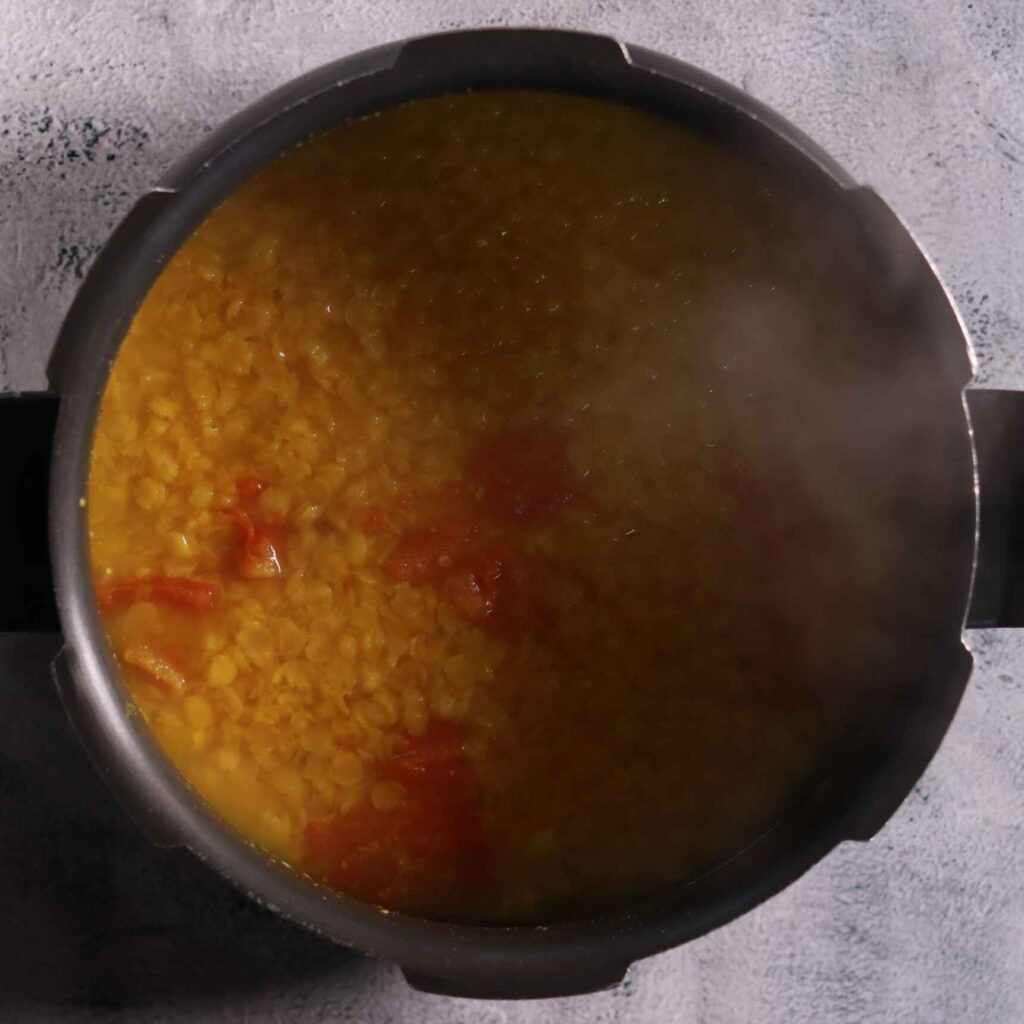
2.Prepping and Cooking the Vegetables
While the dal cooks, prep your vegetables. Drumsticks, carrots, brinjal (eggplant), beans, pumpkin, and shallots are all classic choices. Cut them into bite-sized pieces. In a large pot, sauté onions or shallots in a little oil until translucent, then add the rest of the veggies and stir for a minute. Pour in enough water to cover and simmer until the vegetables are just cooked.
Tip: Add firmer vegetables first, and softer ones like tomatoes and okra later, so everything cooks perfectly.
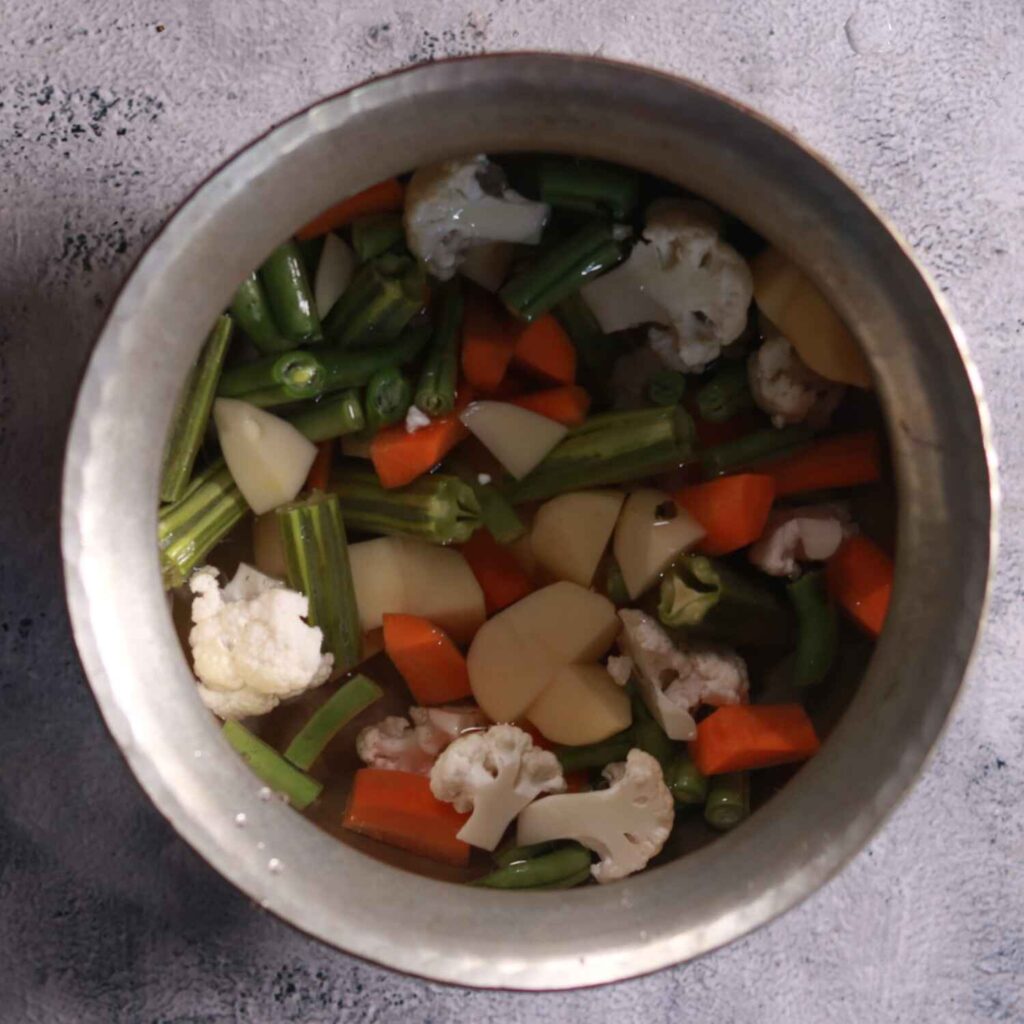
3.Making the Sambar Base: Sambar Powder
Sambar powder is the heart of the dish, infusing everything with warm, toasty spice and a hint of earthiness.
Tip: Homemade sambar powder gives the most authentic flavor, but store-bought works in a pinch.

4.Combining Everything: Dal Meets Veggies
Add the mashed dal to your simmering pot of vegetables and spices. Stir well to combine, and let the sambar simmer for a few more minutes. Adjust the consistency with a little extra water if needed—sambar for rice is usually thicker, while sambar for idli or dosa is a bit thinner.
Tip: Taste and tweak the salt, tamarind, or sambar powder to your liking.

5.The Final Tempering: Flavor Explosion
Heat oil or ghee in a small pan. Add mustard seeds and let them pop, then toss in cumin, fenugreek, dried red chilies, curry leaves, and a pinch of asafoetida. When everything is fragrant, pour this sizzling tempering over the sambar.
Tip: Always add the tempering at the end for the freshest, boldest aroma.
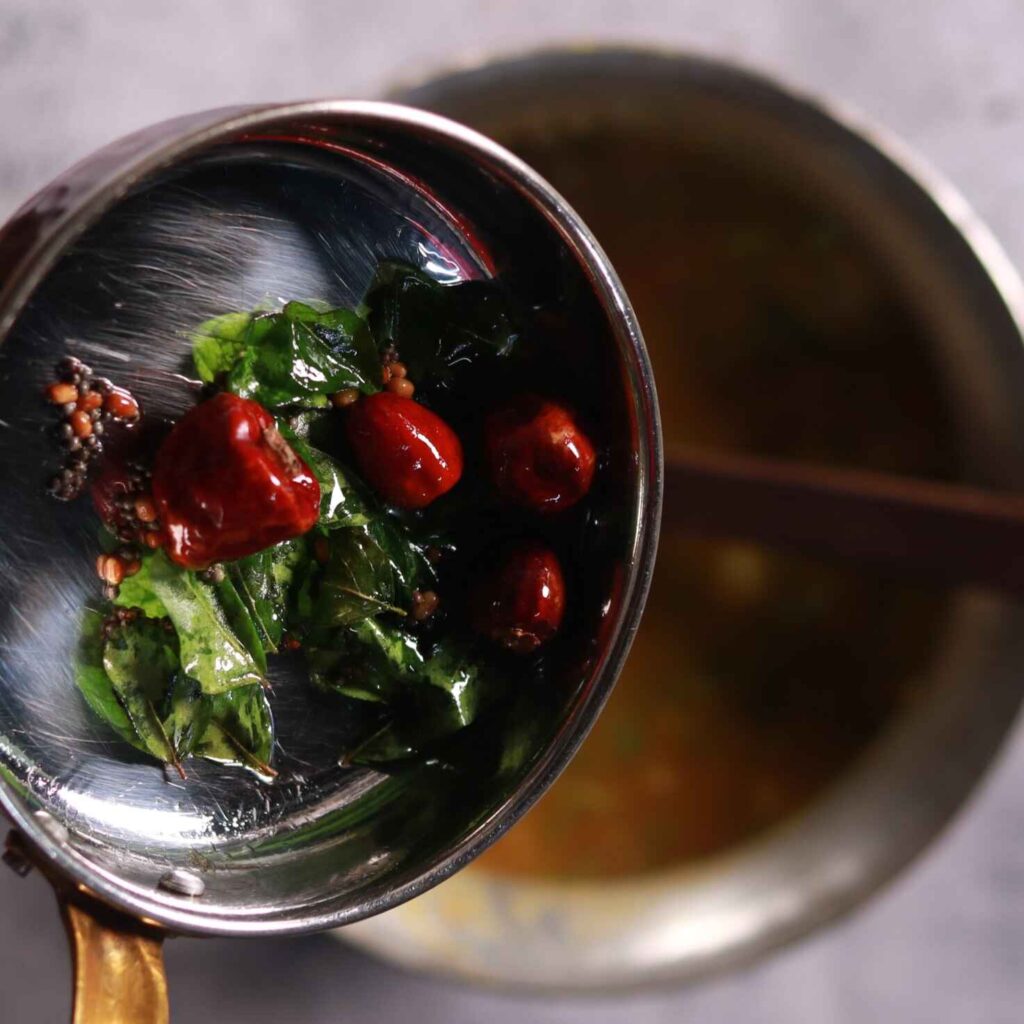
5.Serving and Storing
Garnish with chopped coriander leaves. Serve your Tamil Sambar hot with rice, idli, or dosa. Sambar keeps well in the fridge for up to 2 days—just add a splash of water and reheat gently before serving.
Quick Tips for Authentic Tamil Sambar
- Use fresh dal and vegetables for the best results.
- Homemade sambar powder elevates the flavor.
- Don’t overcook the veggies—they should stay tender.
- Always finish with a fresh tempering.
- Sambar thickens as it sits; thin with water if reheating.
With these steps, you’ll have a pot of authentic Tamil Sambar that’s cozy, nourishing, and full of South Indian flavor—just like home.
Ingredients
Sambar Powder
- 2 tbsp Coriander Seeds
- 1 tsp Chana Dal Split Bengal Gram
- 8 no Dried Red Chilies
- 1 tsp Cumin Seeds
- 1/3 tsp Fenugreek Seeds
- 1 tsp Black Peppercorns
- 2 springs Curry Leaves
- 1/2 cup Grated Coconut
Tamil Sambar
- 1/2 cup Toor Dal Pigeon Pea Lentils, washed and rinsed
- 3 cups Water for pressure cooking dal
- 1 no large Tomato diced
- 1/4 tsp Hing Asafoetida
- 1/2 tsp Turmeric Powder
- 1 tsp Salt adjust to taste
- 2 cups Mixed Vegetables Diced Drumstick, Potato, Carrot, Beans, Cauliflower, Pearl Onion,
- 2 cups Water for cooking vegetables
- 2 tbsp Homemade Sambar Powder
- 1 tbsp Jaggery grated Optional, for mild sweetness
- 2 tbsp Chopped Coriander Leaves
Tempering
- 2 tbsp Oil Sesame or Coconut Oil preferred
- 4 no Gundu Milagai Round Red Chilies
- 1/2 tsp Mustard Seeds
- 1/3 tsp Urad Dal Split Black Gram
- 2 sprigs sprigs Curry Leaves
Instructions
Sambar Powder
- In a Kadai, Dry roast each ingredient for sambar powder separately—coriander seeds, cumin seeds, black peppercorns, chana dal, red chilies, fenugreek seeds, and curry leaves over medium heat until aromatic (about 3-4 minutes per ingredient). and grated coconut till golden color.
- Dry roasted spice is cooled separately before grinding into a fine powder
- Grind into a fine powder. Store in an airtight container.
Tamil Sambar
- In a pressure cooker, add washed toor dal, diced tomato, hing, turmeric powder, salt, and 3 cups of water.
- Cook for 4-5 whistles or until the dal is soft and mushy and set aside.
- In a pot, add 2 cups of water and the mixed vegetables.
- Cook on medium heat until the vegetables turn tender (about 8-10 minutes).
- Add the mashed dal to the cooked vegetables and mix well.
- Add 2 tbsp of the prepared sambar powder, jaggery and stir well. Simmer for 5-7 minutes.
- Stir in chopped coriander leaves, allowing the flavors to blend.
- Heat oil in a small pan.
- Add mustard seeds, urad dal and let them splutter.
- Add dried red chilies, and curry leaves. Fry for a few seconds until aromatic.
- Pour the tempering over the sambar and mix well. Let it simmer for another 3 minutes before turning off the heat.
- Serve hot with steamed rice, idli, dosa, or vada.
Latest posts
-

Authentic Chicken Murtabak
Ever wondered why that crispy, flaky murtabak you had at a street food stall tasted so heavenly? The secret lies in two things: a well-made paratha dough and a boldly spiced murtabah filling. If you love experimenting in… Read more
-

Traditional & Simple Goan Prawns Pulao
If you’ve ever wandered through a Goan kitchen around lunchtime, you’ve probably caught the irresistible aroma of Goan Prawns Pulao wafting through the air. This dish is pure comfort, fluffy basmati rice, plump prawns, and a medley… Read more
-

Easy Homemade Appam Recipe: Soft & Fluffy South Indian Pancakes for Breakfast
If you’ve ever wandered through the bustling streets of Kerala or Tamil Nadu in the early morning, you’ve probably caught a whiff of something warm, slightly sweet, and utterly inviting. That’s appam, it is a… Read more





